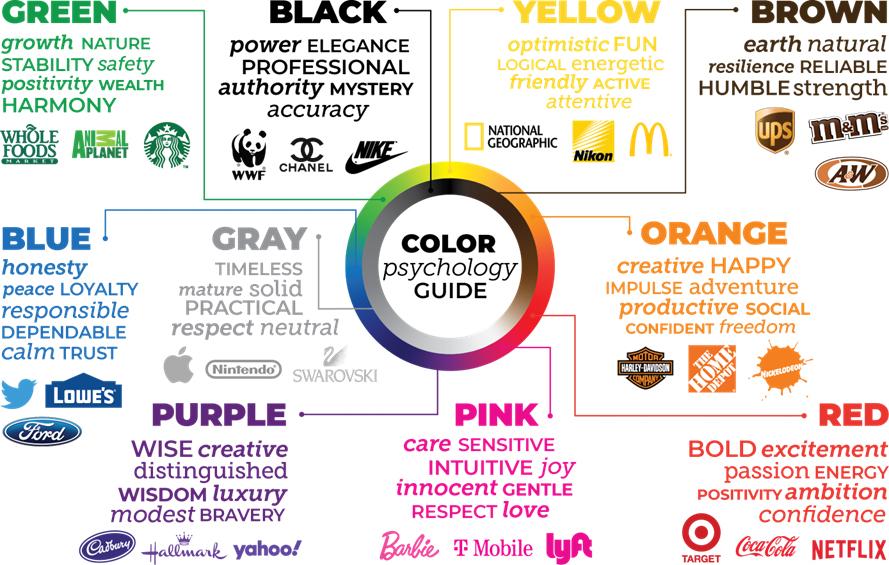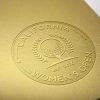
Have you ever wondered why seeing a certain logo can trigger a sudden craving for a hamburger? Or why a specific shade of green can make you feel instantly calm and relaxed? Welcome to the colorful world of logo design and color psychology! In this ultimate guide, we’ll dive deep into the magical realm of hues, shades, and tones, and explore how they can work their subtle (and not-so-subtle) magic on our subconscious minds. So buckle up, grab your paintbrush, and get ready to master the art of color psychology in logos like a true rainbow wizard!
Understanding the Basics of Color Psychology
Ever wonder why certain colors just make you feel all warm and fuzzy inside, while others make you want to run for the hills? Welcome to the wild world of color psychology! Let’s break down the basics, shall we?
First things first, did you know that each color has its own personality? That’s right, folks! It’s like a rainbow of emotions swirling around in your brain. Here’s a quick rundown of what each color brings to the table:
- Red: The color of passion, energy, and excitement. Just like your grandma’s spicy meatballs!
- Blue: The hue of tranquility, trustworthiness, and intelligence. Basically, the color of your favorite snuggle blanket.
- Yellow: The shade of optimism, happiness, and creativity. It’s like sunshine in a bottle!
But wait, there’s more! Colors can also have a physical impact on our bodies. That’s right, folks, it’s like they’re pulling some kind of magical mind trick on us. For example, warm colors like red and orange can actually raise your heart rate and make you feel more energetic. Meanwhile, cool colors like blue and green can have a calming effect and lower your blood pressure. It’s like colors are secretly ninjas, sneaking in and messing with our brains!
![]()
Choosing the Right Color Palette for Your Brand
So, you want to choose the perfect color palette for your brand, huh? Well, buckle up, because we’re about to embark on a wild ride through the color wheel!
First things first, consider your target audience. Are they fun and funky, or classy and elegant? The colors you choose should reflect the vibe you want your brand to exude. Think about it like picking the right outfit for a job interview – you wouldn’t show up in a clown suit, would you?
Next, let’s talk about color psychology. Yes, it’s a real thing! Different colors evoke different emotions, so choose wisely! Here’s a quick rundown:
- Red: Passion, energy, excitement
- Blue: Trust, calmness, professionalism
- Yellow: Happiness, optimism, creativity
Finally, when in doubt, remember the rule of three. A good color palette usually consists of a primary color, a secondary color, and an accent color. This trio will give your brand the visual interest it needs to stand out from the crowd. So, go forth and choose your colors wisely, you color connoisseur, you!

The Impact of Color on Consumer Perception
When it comes to consumer perception, color plays a massive role in influencing how people view a product. Imagine walking into a store filled with dull, gray products. Pretty boring right? Now, switch that to a vibrant, colorful display. Instantly more appealing! Here’s how color impacts consumer perception:
- Color can evoke emotions: Different colors can trigger different emotions in consumers. For example, red might evoke a sense of excitement or urgency, while blue might create a feeling of trust and reliability.
- Color can convey a brand message: The colors you choose for your brand can convey a specific message to consumers. For example, green is often associated with eco-friendly products, while black can convey luxury and sophistication.
It’s fascinating how something as simple as color can have such a significant impact on how consumers perceive a product. So, next time you’re designing packaging or creating a marketing campaign, think about the colors you’re using and the message they might be sending. Remember, it’s not just about the product itself, but how it’s presented that can make all the difference!

Using Color Combinations to Create a Powerful Logo
When it comes to creating a powerful logo, color combinations can make all the difference. You want your logo to stand out and leave a lasting impression, so choosing the right colors is key. Here are some tips and tricks to help you create a killer logo using color combinations:
Think about the emotions you want to evoke: Different colors can evoke different emotions, so it’s important to consider what feelings you want your logo to convey. For example, red is often associated with passion and energy, while blue can symbolize trust and professionalism. Choose colors that align with the message you want to send.
Consider color theory: The way colors interact with each other can have a big impact on how your logo is perceived. Complementary colors, which are opposite each other on the color wheel, can create a bold and eye-catching logo. Analogous colors, which are next to each other on the color wheel, can create a harmonious and cohesive look.
Don’t be afraid to get creative: Play around with different color combinations until you find one that really pops. Think outside the box and don’t be afraid to take risks. Sometimes the most unexpected color combinations can result in the most memorable logos.

The Psychology of Specific Colors in Logo Design
Have you ever wondered why some logos make you feel hungry, while others make you feel calm and relaxed? It all comes down to the psychology of colors in logo design. Each color has its own unique way of affecting our emotions and perceptions, and clever designers use this to their advantage.
Let’s break it down:
- Red: This color is all about passion and energy. It’s no wonder so many fast food chains use red in their logos – it’s like a visual cue to your brain that says, “Eat here now!”
- Blue: The color of trust and stability. That’s why you see so many banks and tech companies using blue in their logos. They want you to feel like you’re in good hands.
- Yellow: The color of happiness and optimism. Think about how many smiley faces are yellow. It’s like a little ray of sunshine in logo form.
So next time you see a logo that makes you feel a certain way, take a closer look at the colors they’re using. There’s a good chance they’re playing some sneaky mind games with you!
Tips for Testing and Refining Your Logo’s Color Scheme
So you’ve got a logo, but you’re not quite sure if the color scheme is hitting the mark. Fear not, dear logo designer, for we have some tips to help you test and refine those hues to perfection!
First things first, make sure you test your logo in different contexts. Is it still popping on a busy background, or does it get lost in the chaos? Try it out in various settings to ensure it stands out wherever it goes.
Next, consider color psychology. Different colors can evoke different emotions in people. Is your logo conveying the right vibe? Use this to your advantage and choose colors that align with your brand’s personality.
Lastly, don’t be afraid to get feedback. Show your logo to friends, family, even strangers on the street. Their input can be invaluable in helping you see things from a different perspective. Plus, who doesn’t love a logo critique session over a cup of coffee?
Successful Examples of Brands Using Color Psychology in Logos
Have you ever wondered why certain logos just make you feel a certain way? It’s all thanks to the magical powers of color psychology! Here are some successful examples of brands using color psychology in their logos:
1. McDonald’s: The golden arches of McDonald’s logo are a perfect example of using color psychology to entice customers. The bright yellow color is known to evoke feelings of happiness and warmth, making you crave that Big Mac even more!
2. Coca-Cola: The classic red and white colors of Coca-Cola’s logo are no accident. Red is a color that stimulates appetite and is often associated with energy and excitement. No wonder why a cold Coke always hits the spot!
3. Starbucks: The comforting green of Starbucks’ logo is meant to evoke feelings of relaxation and rejuvenation. It’s no wonder why a trip to Starbucks always feels like a little slice of zen in a hectic world.
FAQs
1. How can color psychology impact brand perception in logos?
Color psychology can either make or break a logo. The right colors can evoke emotions and create associations that resonate with your target audience, while the wrong ones can leave your customers scratching their heads wondering what you were thinking.
2. Are there any rules to follow when choosing colors for a logo?
Yes, there are some general guidelines to keep in mind when selecting colors for your logo. For example, warm colors like red and yellow can convey energy and passion, while cool colors like blue and green can evoke feelings of calmness and trustworthiness. But remember, rules are made to be broken (just like hearts).
3. Can using multiple colors in a logo be beneficial or should I stick to one color?
Using multiple colors in a logo can add depth and complexity to your design, but it’s important to use them wisely. Too many colors can overwhelm the viewer and dilute your brand message. Think of it like a buffet – a little bit of everything is good, but too much will leave you feeling queasy.
4. How can I test if my chosen colors are resonating with my target audience?
One way to test if your chosen colors are hitting the mark is to gather feedback from your target audience. Conduct surveys, focus groups, or A/B testing to see which colors resonate most with your customers. Just remember, surveys are like opinions – everyone has one.
5. Can colors in a logo affect consumer purchasing decisions?
Absolutely! Colors can subconsciously influence consumer behavior and purchasing decisions. For example, studies have shown that the color red can create a sense of urgency and encourage impulse buying, while blue can promote trust and reliability. It’s like playing mind games, but with colors instead of cards.
Now go forth and conquer the psychology of color in your logos!
Remember, the power of color is in your hands (or should we say, in your RGB codes?). Use this ultimate guide to channel your inner color guru and create logos that speak to the hearts and minds of your audience. And who knows, maybe one day you’ll be hailed as the Picasso of logo design, the Monet of marketing. Embrace the rainbow, my friends, and let your logos shine brighter than a double rainbow after a summer shower.











